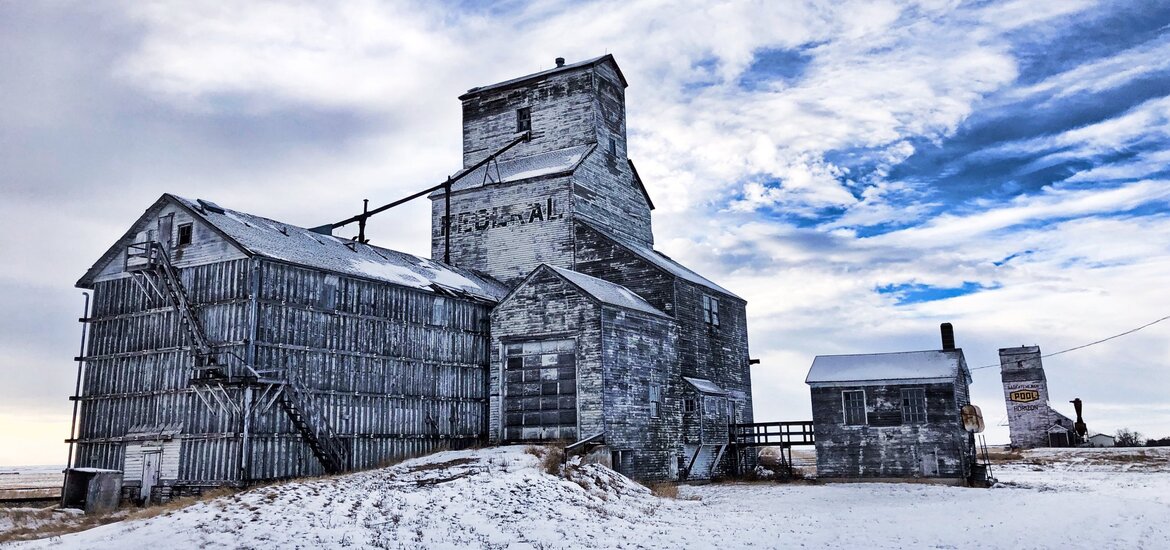Written by David Siebert, Researcher for Heritage Saskatchewan, with input from various HS Staff
In November 2022, CBC News published an article about the deconstruction and material reuse of grain elevators. It sparked a conversation in our office. We liked that it was not a eulogy to another fallen grain elevator and showed a proactive use for a heritage site that respected the materials and their history. While it is sad to see grain elevators dismantled in this way, keeping the old growth wood in circulation is arguably much better than burning or landfilling valuable and useful material.
Grain elevators are considered by many to be icons of our province (at least, the southern, agricultural part of the province) and landmarks in more ways than one. They are markers of identity, either provincial or local. The sites have a complicated history - they tell the story of settlement and colonialism as well as social history of rural Saskatchewan, changes to agriculture and rural communities, and our relationship to the land and to the nation. They were practical, useful, industrial buildings, but now are seen as either aesthetic set pieces, places of memory and nostalgia, or a site on a museum map. None of these current uses are 'bad' - they simply are. The question we ask is, what do we value about these places, and are we making decisions that support these values?
Over the past decades, more and more of these structures have disappeared due to neglect, intentional demolition, vandalism, or the forces of nature. Over the next decade, we will lose many more. If in December of 2032 there are only a dozen elevators left in Saskatchewan, how will we feel about that?
There are, however, opportunities at this point. Similar to citizen science, there are ways that interested community members could document existing elevators, both their tangible and intangible past. Likewise, though there are several elevators in museums around the south of the province, are these properly designated? Are they in working order? Do we want to put the money forward to fully designate, rehabilitate, and work an elevator to commemorate both the building and the know-how needed to work one, maybe as a National Historic Site? Or is it more important that communities have a direct say in the tangible conservation and presentation of their own grain elevators?
There is surprisingly little research into the socio-cultural importance of grain elevators in southern Saskatchewan. Over the decades these buildings were used and interacted with by different people, from the farmers and operators to the people who built and maintained the buildings. There is a largely unknown history of how Métis labourers contributed to the construction of elevators.* There is a lack of research related to Indigenous perspectives related to grain elevators and the agricultural industry they represent. There is little understanding of how newcomers to Saskatchewan or youth relate (or fail to relate) to grain elevators.
In 2018, Heritage Saskatchewan made a small contribution to the understanding of elevators alongside the community of Val Marie. Following that link, you will find people's reflections on the Val Marie grain elevator, including high school students who, before the project, had no personal attachment to the site. Through research, storytelling, and site visits, they made a connection to the place and developed a new relationship to the structure as well as to older members of their community. The value of the grain elevator in Val Marie is shown through the stewardship decisions made by the community. More research can be done in this area.
Ali Piwowar, an architect, has shown that these structures could be adaptively reused in innovative ways that serve contemporary needs. Referring back to the CBC article linked above, ABMT Wood Solutions has shown that the wood that the elevators are made from is salvageable and useful. The size and quality of lumber used to build grain elevators a century ago simply doesn't exist anymore, and respecting that material by putting it to use in contemporary contexts is arguably better than the alternatives (landfill, burning, etc.). Is this something we want to encourage through policy and legislation, as other jurisdictions have done?†
Heritage is a choice we make. Maintenance, neglect, adaptive reuse, or material reuse are all choices. What do our choices say about our values? What does it say about us if we keep the elevators? If we don't? And who is responsible? Individual citizens? The government? What level of government? Do we want them conserved for their commemorative value, practical usefulness, aesthetics, or as a place for nesting birds?
Heritage, at its most basic, is about what we are bringing into the future. We don't know what the future holds and what future citizens may need. We do know that what survives into the future is a choice we make today, and tomorrow, and tomorrow's tomorrow. Saskatchewan’s wooden grain elevators will not survive into the future without our efforts. Should they survive? Are we willing to make an effort?
What is your relationship to the remaining grain elevators around southern Saskatchewan? What do you think should happen to them?
*Pearce, Nick. “Once Rural Landmarks, Wooden Grain Elevators Are Disappearing from Saskatchewan.” The Star Phoenix, 17 Dec. 2020, https://thestarphoenix.com/news/local-news/once-rural-landmarks-wooden-grain-elevators-are-disappearing-from-saskatchewan.
†Strain, Brendan. “Victoria Passes Demolition Waste and Deconstruction Bylaw.” CTV News, 23 June 2022, https://vancouverisland.ctvnews.ca/victoria-passes-demolition-waste-and-deconstruction-bylaw-1.5960932.


